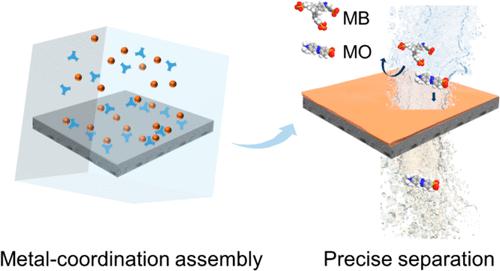当前位置:
X-MOL 学术
›
ACS Appl. Nano Mater.
›
论文详情
Our official English website, www.x-mol.net, welcomes your
feedback! (Note: you will need to create a separate account there.)
Metal–Phenolic Acid Networks Enable Nanofiltration Membranes for Rapid and Precise Molecular Separation
ACS Applied Nano Materials ( IF 5.3 ) Pub Date : 2023-06-06 , DOI: 10.1021/acsanm.3c01968
Ping Fu 1 , Chang Liu 1 , Wan-Long Li 1 , Di Zhou 1 , Xiao-Jun Huang 1 , Zhi-Kang Xu 1 , Ling-Shu Wan 1
ACS Applied Nano Materials ( IF 5.3 ) Pub Date : 2023-06-06 , DOI: 10.1021/acsanm.3c01968
Ping Fu 1 , Chang Liu 1 , Wan-Long Li 1 , Di Zhou 1 , Xiao-Jun Huang 1 , Zhi-Kang Xu 1 , Ling-Shu Wan 1
Affiliation

|
Molecular sieving membranes based on molecular deposition have attracted extensive attention over the past several decades. However, the building blocks are mainly limited to catechol-based compounds, which possibly result in complexity of the ultimate selective layer. It is still a great challenge to construct selective layers of molecular sieving membranes using other building blocks. Herein, composite nanofiltration membranes with metal–phenolic acid networks as the selective layers are first demonstrated for molecular sieving. Represented by Fe3+–ferulic acid (FA) networks with a thickness of about 100 nm, they are facilely constructed at the interface of the deposition solution and porous substrates through a coordination interaction between metal ions and ten kinds of organic ligands. The coordination mechanism is further elucidated by molecular dynamics simulation. The resultant defect-free and robust composite membranes show great potential in rapid and precise separation performance for dyes as well as mixtures of dyes and inorganic salt ions. The water flux is as high as 87.7 L/(m2 h bar), and the rejections for methyl orange (MO, 327 Da) and methyl blue (MB, 800 Da) are about 20.1% and 98.0%, respectively. The separation mechanism has also been discussed. In addition, the composite membranes have sufficient pH stability and long-term operation stability. The present system expands the toolbox of membrane building blocks and provides an approach to the design and fabrication of composite separation membranes based on metal–phenolic acid networks.
中文翻译:

金属-酚酸网络使纳滤膜能够实现快速、精确的分子分离
在过去的几十年里,基于分子沉积的分子筛膜引起了广泛的关注。然而,构建块主要限于儿茶酚基化合物,这可能导致最终选择层的复杂性。使用其他构件构建分子筛膜的选择性层仍然是一个巨大的挑战。在此,首先证明了以金属-酚酸网络作为选择性层的复合纳滤膜用于分子筛分。以Fe 3+为代表–阿魏酸(FA)网络厚度约为100 nm,通过金属离子与十种有机配体之间的配位相互作用,在沉积溶液和多孔基材的界面上轻松构建阿魏酸(FA)网络。通过分子动力学模拟进一步阐明了配位机制。所得的无缺陷且坚固的复合膜在染料以及染料和无机盐离子的混合物的快速和精确分离性能方面显示出巨大的潜力。水通量高达87.7 L/(m 2h bar),甲基橙 (MO, 327 Da) 和甲基蓝 (MB, 800 Da) 的截留率分别约为 20.1% 和 98.0%。还讨论了分离机制。此外,复合膜具有足够的pH稳定性和长期运行稳定性。本系统扩展了膜构建模块的工具箱,并提供了一种基于金属-酚酸网络的复合分离膜的设计和制造方法。
更新日期:2023-06-06
中文翻译:

金属-酚酸网络使纳滤膜能够实现快速、精确的分子分离
在过去的几十年里,基于分子沉积的分子筛膜引起了广泛的关注。然而,构建块主要限于儿茶酚基化合物,这可能导致最终选择层的复杂性。使用其他构件构建分子筛膜的选择性层仍然是一个巨大的挑战。在此,首先证明了以金属-酚酸网络作为选择性层的复合纳滤膜用于分子筛分。以Fe 3+为代表–阿魏酸(FA)网络厚度约为100 nm,通过金属离子与十种有机配体之间的配位相互作用,在沉积溶液和多孔基材的界面上轻松构建阿魏酸(FA)网络。通过分子动力学模拟进一步阐明了配位机制。所得的无缺陷且坚固的复合膜在染料以及染料和无机盐离子的混合物的快速和精确分离性能方面显示出巨大的潜力。水通量高达87.7 L/(m 2h bar),甲基橙 (MO, 327 Da) 和甲基蓝 (MB, 800 Da) 的截留率分别约为 20.1% 和 98.0%。还讨论了分离机制。此外,复合膜具有足够的pH稳定性和长期运行稳定性。本系统扩展了膜构建模块的工具箱,并提供了一种基于金属-酚酸网络的复合分离膜的设计和制造方法。

































 京公网安备 11010802027423号
京公网安备 11010802027423号